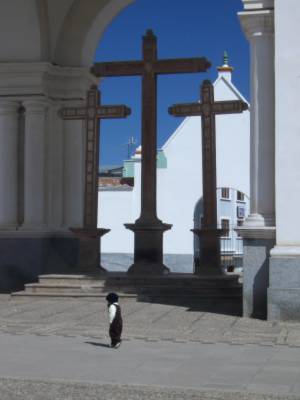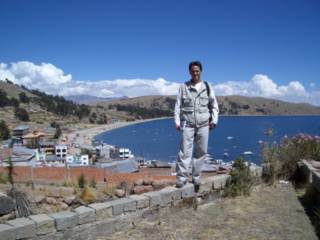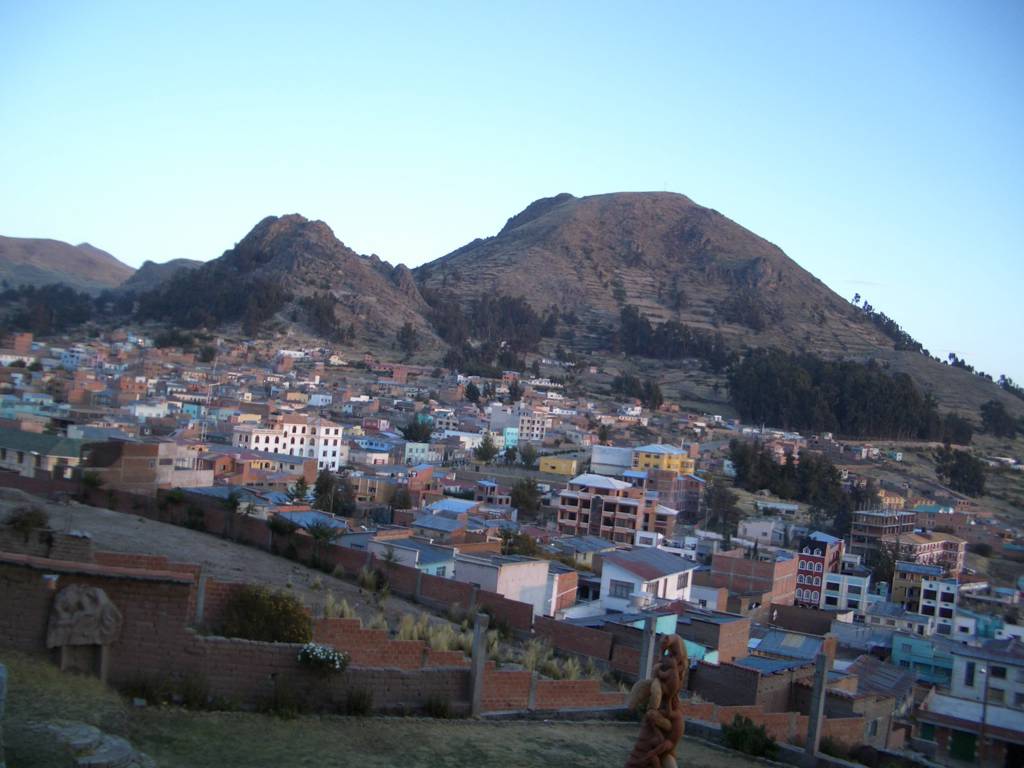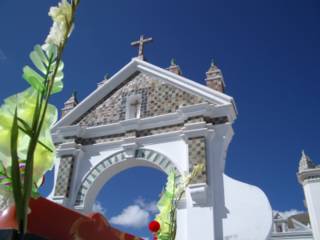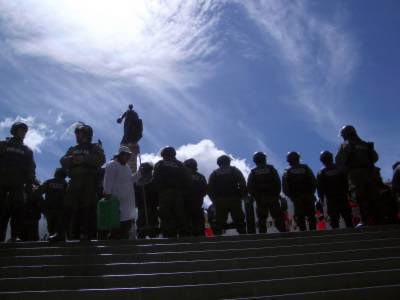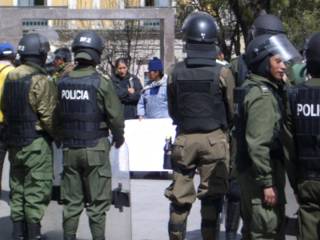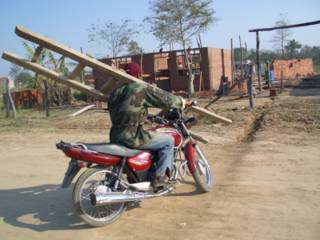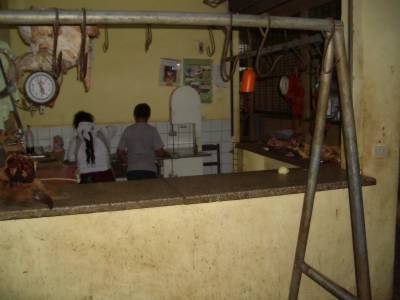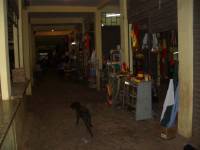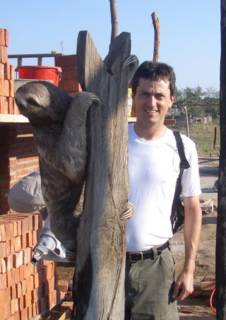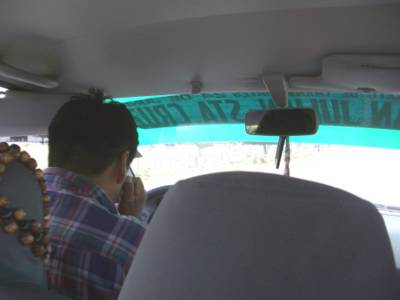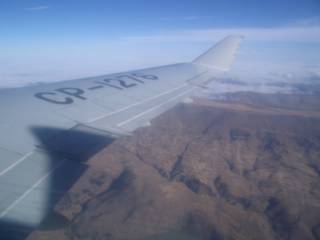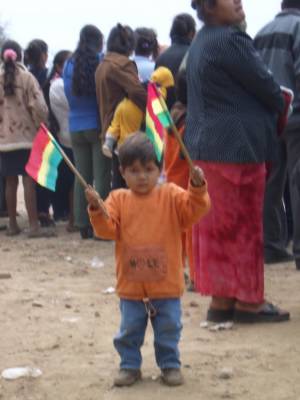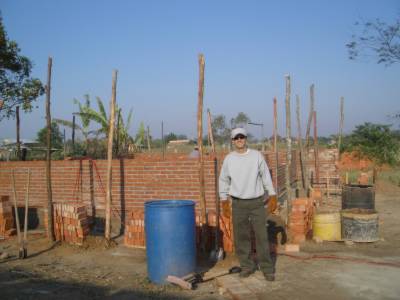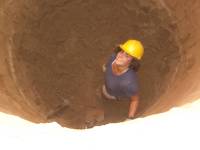On the shores of Lake Titicaca is the festive little town of Copacabana, founded by Spanish Conquistador Barry Manilow in 1978. But the history of the place goes back at least as far as an Incan settlement on the site well before the Spanish arrived in the 16th century.
And before the Incas extended their empire in the area, the Aymara had established a society that worshiped the Sun, the Moon, Mother Earth, and other gods. One of these gods was the human-headed fish figure, Copacahuana, whose name means "view of the lake."
The Incas suppressed the Aymara religion, but when the Spanish arrived and pushed the Incas aside, the Aymara converted to a Christianity which incorporated many Aymara influences. Eventually, the locals chose La Santissima Virgen de Candelaria to be their patron saint and placed a clay statue of her on their adobe altar. But they decided that this statue was pretty shabby, so the sculptor tried again, this time in wood, and folks were very happy with the result. In 1605 priests told them that it was time for a cathedral worthy of their saint. It took 10 years to complete the altar portion and install the wooden lady in her permanent place above it. The rest of the Moorish influenced cathedral took 200 years to complete, but the miracles and healings started early on. Today, the town founded originally as an Incan stop-over for pilgrimages to sites of human sacrifice on Lake Titicaca is, itself, a destination of Christian pilgrims.
The protests in Plaza Murillo during the second week of August, 2004, were low key and apparently routine. On the day I was there, about 40 men and women – mostly indigenous laborers, some very young – were picketing in the center of the plaza. There was no loud speaker or music or chants; everyone was just standing around as if waiting for something to happen. Protestors would come and go, making their way through the ring of police, who blocked them from view of traffic and passersby. The facades of Congress and the Presidential Palace adjacent to the plaza were unobstructed and seemed very business-as-usual. In the center of the plaza, protestors quietly held their turf, and the police, though dressed in riot gear, did not assume an otherwise threatening posture. This was my encounter with Bolivia’s low-key but tense status quo in 2004, one of protests and labor actions like the air traffic controller strike that had diverted my flight to Cochabamba (see October 2 below).
This week's confrontations mark the end of an 18-month truce in Bolivia’s “gas war” which resulted in 67 deaths and the resignation of President Lozado. His contracts with multinationals to develop Bolivia’s very large natural gas reserves had enraged left-leaning Bolivians who favor nationalization of the oil and gas industry. Carlos Mesa succeeded Lozado and was able to establish a period of dialogue and debate. But now that truce is faltering, and President Mesa is announcing his resignation after less than two years in office.
The distribution of Bolivia’s gas and oil wealth is only one of a variety of issues heating the country up. If you want to know more about this from people who understand much more than I do, go to Jim Shultz’s excellent blog.
Nothing tests your desire for a warm shower like the site of a shabby electric water heater built directly into a leaky shower head. Stepping into this chamber on my first morning at the hostel felt like some sort of initiation, a joke to see which rookies would be foolish enough to stand naked on a wet concrete floor and touch a contraption connected to 230 volts by ten-gauge wire and electrical tape. All I needed was a black hood and a some reconnections of the wires in unspeakable places, and the Abu Graib image would be complete.
I decided to opt for the cold shower in the next stall. A few days later, even that option fell to some sort of technical failure, and I had to settle for a bucket shower.
Eventually, I did give the electric heater a half-hearted effort. I tapped on the breaker switch and jiggled the shower head, according to directions from my fellow Habitat volunteers. People I trusted. With my life. At one point, the water in the shower head gave a mechanical moan and drew some of the electrical current from the light bulb hanging by a wire from the ceiling. I screamed twice, first from the sudden splash of hot water – way too hot – and then from the sudden ice cold water that followed. As the shower head moaned again, building up for another assault on my goose bumped skin, I killed the water pressure and used my rubber flip-flop to knock the circuit breaker on the wall to its off position. Then I used it to swat a mosquito.
When our pozo got too deep for our ladder, we fell into thoughtful discussion about how to deal with the situation. But Hector, wasting no time with talk, hopped on his bike. Moments later he returned and spliced this ladder to our old one. Problem solved. The locals carry all kinds of stuff on motorcycles: propane tanks, large chain saws, 20-foot segments of copper piping, wheel barrows, and their grandmothers... Who needs SUV's?.
No pesky health codes or intrusive waste management laws are hampering free enterprise at the San Julian market. These are the images that come back to my mind when wing nuts – the kind that presently run our country – talk about getting the government and its regulators out of the affairs of people.
At markets like this in
The market covers about three acres of space. Much of it is housed in a one-story concrete structure consisting of small compartments, like storage rooms you would rent at a u-store-it facility, with the heavy roll-up steel garage doors and padlocks, opening onto three or four corridors. The dark concrete floor sucks up what little brightness is offered by the harsh and glaring fluorescent lighting.
The market spills out behind the structure in a series of large tables and booths, some covered by tents or canopies. Spigots and hoses cropping up from the ground are the only sign of running water to these outdoor vendors, and drainage is provided by shallow stagnant ruts aside the dirt corridors.Back inside, the chickens were waiting uncovered and unrefrigerated for buyers on the countertop at about ten o’clock in the morning when I took these pictures. Hours later, I returned to the market for a six-pack (very well refrigerated) and noticed that a couple of the chickens had been bought, or perhaps they’d been carried off by some of the flies.
One morning we arrived at the construction site to find a sloth crawling across the road. Its destination, apparently, was the eight-foot scaffolding post near the front of the house.
Sloths spend almost all of their time in trees where their camouflage and stillness keep them from drawing attention of eagles and jaguars. When sloths come down, it’s usually for their weekly bathroom break, and that’s when they are most vulnerable. It seems that Mother Nature could have gone the extra mile and provided sloths with a bombardier style potty instinct; but as sloths tend to hang leg-high in the trees, it’s probably a good thing they don’t attempt this.
Our sloth had the misfortune of coming down from the tree across the street from our work site just as a group of school kids was walking by. The kids had scared the sloth away from its preferred tree and the poor animal was “fleeing” across the street to our scaffolding, the only other reasonably high refuge in the immediate surroundings.
Eventually the sloth made it, but then Julian, one of our brick masons, put it back in the road so we could all watch it crawl some more. Julian offered to straightjacket the freaked out critter in some newspaper and then wheel-barrow it the 8 blocks – on bumpy unpaved roads – for a show-and-tell at the other Habitat site. But fortunately Doug was able to find the right Spanish words and convince Julian to carry the sloth back to its original tree across the street.
This is a three-toed sloth, as opposed to a two-toed sloth. The distinction is made not by the number of toes – all sloths have three toes on each of their two hindfeet - but by the number of “fingers” on their “hands." I found my photo op while the sloth was crawling up a scaffolding post, and I was glad not to discover if the sloth uses these claws defensively.
The home right behind the Habitat lodge had a rooster. I can’t remember what his name was, but I wanted to kill him. This vile bird’s favorite place to hang out was right outside the back air vent (really just a screened slit in the brick wall) of our room. This put the rooster about 3 feet from the head of my roommate Doug. Starting at about 10 o’clock every night, he and all the other roosters for miles around would have a contest to see who could shatter the air into the tiniest pieces. This contest would last until breakfast. I could swear that he must have been putting his beak right up to that air vent and aiming the focus of his shock-wave at my head. One morning I saw the rooster in our courtyard. Brave little creature. He was lucky I had my camera and not my pocket knife.
From the early 1600’s to the mid-1700’s, the Jesuits maintained a relatively benevolent patriarchy through their South American missions. While the relationship was a component of Spain’s colonialism serving ultimately to extract mineral wealth from South America, there were some notably progressive features of the Jesuit system of missions. Typically, the Jesuits administered their affairs with a balance of religious and secular aims. Preaching the Gospel and converting natives to Christianity were, naturally, high priorities of the priests. But so was the preservation of native culture, arts, and languages. The Jesuits were successful at teaching agriculture to the native hunter-gatherers, partly because they combined native music and customs with the practices of planting and harvesting. The Jesuits taught birth control, advocated against capital punishment, and established shorter work days than did other Catholic missionaries. Jesuit negotiations with the Spanish crown protected natives from the Spanish system of encomiendos, which was essentially a form of enslavement in mines and other labor-intensive enterprises throughout colonial South America.
Naturally, Jesuits’ willingness to run against the grain of all-out exploitation was not met with great approval by Spanish or Portuguese governments who competed with each other for territory and economic gain and did not welcome additional competition from the Jesuits. Nevertheless, for a century and a half, the Jesuits gained power and control in remote jungle areas away from the Spanish and Portuguese footholds. The Jesuits were also falling out of favor with the Catholic Church which did not take kindly to their relative independence from papal authority.
Meanwhile, slave traders grew more aggressive in hunting for prey in Jesuit territory, despite previous agreements. But the natives, armed by Jesuits, formed militias and fought back. In 1756, Spanish and Portuguese armies attacked and destroyed many of the Jesuit missions, and in 1767 the Jesuits were run out of colonial South America.
The expulsion of the Jesuits was part of a larger worldwide suppression spearheaded by Pope Clement XIV and European governments. But in 1814, Pope Pius VII restored the Society, and over the years Jesuits have reestablished their missionary presence throughout the world.
She was resting on a corner a few blocks from the Habitat lodge. Across the street was another one, just as black but smaller.
In the 1700’s, folk wisdom in the English country-side noted that milkmaids frequently contracted cowpox but did not contract smallpox. It was pretty clear that cowpox inoculated them against smallpox. A doctor named Edward Jenner tested this by injecting an eight-year-old boy with fluid from a cowpox pustule. As expected, the brave lad suffered the relatively mild symptoms of cowpox. He was then exposed to smallpox but did not get ill. This is the famous discovery of the smallpox vaccine.
Vaca means cow in Spanish, from the Latin vacca.
Early one evening, we took a tour of some nearby homes recently built by Habitat. The typical home has a common room which serves as the living/dining room, usually about fourteen-by-twenty feet, and two bedrooms about ten-by-fifteen feet. On the back of the home is a connected outhouse, with a nearby tap or well pump. Some of the food preparation takes place on a patio, but a few of the homes I saw had portable gas-burning stoves inside, near windows for ventilation. The homes are wired for electricity but have no indoor running water.
A family that moves into such a home is, for the first time, living under a roof that does not leak and on a floor that is not made of dirt. Eliminating rain water, mud, infestation, and wind from living quarters has huge implications for health and hygiene – particularly for small children.
One home we visited had a desktop computer with a DVD drive, and the little boys were very proud of their collection of movies. I was surprised to see that their latest acquisition was Shrek 2, which had just been released in theaters in the US a few days before my trip.
My ride to retrieve luggage that morning was shared with Rachel, another Habitat volunteer delayed by the strike. She had waited out the labor dispute in Bogotà and flew into Santa Cruz a few hours after me. Rachel was nice enough to take the cab out to the airport with me in case I needed her fluent Spanish.
Once I had my bag, Carmen put Rachel and me in a taxi for the two hour ride to San Julian.
All the cab drivers I met in Bolivia were pretty sociable. But not this guy. We never even got his name. We tried to make small talk by asking him about the CD he was playing, but he just grumbled - which in Spanish sounds the same as in English. After a short while on the narrrow road, I was a little concerned to see him rubbing his eyes and drooping his head. We were traveling about 70 mph with no seat belts, and he looked like he might pass out. At the same time, he was treating the pot holes like a slalom course, using both lanes and both shoulders. Sometimes it was hard to tell if he was carving his path or weaving off the road.
Rachel and I gave him some crackers to wake him up. Then we noticed him sniffling, and he sneezed a few times. Maybe he was not tired at all, maybe allergies were making his eyes itch. And, as for the drooping head, that was the only way he could see under the huge green decal at the top of his windshield. So, we chose to believe these things and enjoy the thrill ride.

Crossing Rio Grande o' Guapay at Puerto Palias. The
railroad bridge serves cars and trains one direction
at a time.
Thanks to the strike, I didn’t get to Santa Cruz in time to rendezvous with all the other Habitat volunteers. They had flown in from Miami just before the strike and hired a van to San Julian two hours away. So, when I landed the next afternoon, I was grateful that the local Habitat affiliate sent a coordinator, Carmen, to greet me at the airport.
She found me filling out some lost luggage papers and trying my best to speak Spanish to Lissandro, the lost luggage go-to guy at the Santa Cruz airport. At first I thought he was fluent in English because he spoke such perfect grammar with barely any accent. “Your bags will be here, Mr. Troy. Please, do not worry. I am certain they will arrive tomorrow morning. Go to your hotel and have a comfortable night. Come back tomorrow, and your bag will be here. Everything will be OK.” It made me think of a valet offering pleasant accommodations to James Bond just before planting snakes in his suite. And when I pressed him on the details, like which flight the bag would be coming in on and if there were any way to use the bar code on my claim check to track the bag’s present location, it became clear that he was only performing lines well rehearsed for Americans. So I managed to dig deep for the Spanish phrases I needed, and despite Lissandro’s apparent unfamiliarity with the technological breakthrough we know as bar codes I got the answers I wanted to hear. Somehow Lissandro’s optimism was rubbing off on me. Images of my bag being eviscerated in the lost luggage office of the Mexico City airport began to fade.
On the cab ride to the hotel, Carmen was also optimistic. After a few days in Bolivia, I started to see this pattern in the people I met there. They deal with set-backs all the time, and they just seem to plow steadily ahead. Like on the plane, when the pilot announced our diversion to a different city. No one had reacted with more than a shrug. If that were to happen on an American domestic flight, some drunken passenger would scream out his demands to see Wilbur Wright immediately.
Carmen checked me into the hotel, courtesy of Habitat, and explained to the front desk that I would need an airport taxi first thing in the morning. It was now the hotel manager’s turn to be reassuring. “Oh, Mr. Troy, you will have no problems getting your luggage. It is being well cared for. In the morning you will have a nice breakfast, and your luggage will be waiting for you at the airport.”
My room was small but very comfortable, if a bit chilly with no heating system at all. What I didn’t yet know about Bolivian hotels is that if you want heat, the front desk will send up a space heater for a few extra bolivianos. I took a cold shower because I didn’t know how to work the electric water heater. Then I crawled into bed, but the thin blanket was not enough. So the front desk sent me a thicker one. I rolled myself burrito-style into the blankets and slept like a baby.
The next morning, I had a nice breakfast. The cab driver arrived as soon as I was ready. I found my bag and all its contents at the airport just like everyone said I would.
I woke at 4:00AM with about an hour left of my long flight from Mexico City to Santa Cruz, Bolivia. That’s when the pilot made an unexpected announcement.
Bolivia’s air traffic controllers had gone on strike – while I was in mid-flight – and we would be diverted to Cochabamba.
No one knew if the strike would last an hour, a day, or a month. While waiting for my luggage to come out on the carousel at the Cochabamba airport – which it never did – I considered taking a bus to Santa Cruz, but that would have been eleven hours of uncomfortable traveling.
The airline put us up in a four star downtown hotel where I had a nice breakfast, a nap, and a hot shower. But no fresh clothes and no shave. All that stuff was in my checked luggage, and who knew where that could be? My jacket was also in that bag, and Cochabamba was cool and cloudy – in the low 50’s.
There were about sixty of us from two different Lloyd Aereo Boliviano flights staying at the hotel. One of my fellow passengers was a missionary originally from Florida. She and her husband had been living in Uruguay with their four kids and were in the process of moving to Bolivia. But the somewhat arbitrary entry taxes were forcing them to store their furniture at the border until they could negotiate lower property taxes. She described it all as a system of semi-legalized bribes. Her trip that week had been to Florida to look into a possible move back to the states.
Throughout the morning there was no news about the strike. But at one o’clock, just as we were finishing the buffet lunch, fifteen taxis pulled up to the front of the hotel and hurried us back to the airport.
After about two hours of waiting, we boarded our plane and waited another hour. We taxied out. Then we taxied back to the terminal. The pilot announced we needed a different plane. Then, he decided this one was fine. We taxied back out again and finally took off.
But the question remained. Where the hell was my luggage?

The buses to downtown hotel, courtesy of Lloyd
Aereo Boliviano. The vacated control tower
in the background.
I read somewhere that Bolivia is practically synonymous with the word “coup” and that it has had over 190 coups since Simon Bolivar helped liberate the country 1825. Well, indeed, that seemed like a lot to me. It comes out to one coup every 344 days! Could this mean that I was flying into a danger zone? Was Bolivia due for more turmoil? Of course I was only planning to stay for about 3 weeks, so certainly I’d be in and out of the country before any long smoldering conflicts re-ignited into inescapable violence, right?
Actually, it’s been about 23 years since the last coup. So Bolivia is a fairly stable democracy, even though anti-government protests left 59 people dead in October, 2003.
Recently, I got to wondering if it was fair that Bolivia’s reputation is so tarnished with the “c” word. I did some research, trying very hard not to surpass the minimum standard of journalistic research established by Drudge Report and Bill O’Reilly. I Googled “coup Bolivia” and got 89,000 matches. When I Googled “coup Haiti,” I got 167,000 matches, proof - at least according to todays's journalistic standards - that in the competition for Coup Capital of the World, Bolivia is far outpaced by Haiti. I continued Googling and found that, as rough as it is in Haiti, Venezuela must be even worse, with 269,000 hits, three times as many as Bolivia.
Knowing that most coups are the result of meddling by the imperial powers, I figured Google would help shed some light on this part of the story as well. The “coup United States” search yielded a whopping 1,090,000 hits. China had only 433,000, and the woeful USSR could muster only 71,500. The Brits registered a disappointing 178,000. Could it be that no one tops the US in this dubious tally of meddling? I could think of only one other possible country. So I ran the Google, and yes, just as I thought. First place goes to France: 1,580,000 hits.
So, there you have it. Simple research. Simple conclusions. Now all I need is a TV news studio and a satellite.
Independence from Spain in 1825 did not free Bolivia from conflict or guarantee sovereignty. And it certainly did not fix the borders. Initially, Bolivia covered about twice as much land as it does today. But once free of Spanish colonialism, it proceeded to lose large chunks of its territory to it neighbors during the next 110 years. One of the most devastating of these losses came in a war against Chile which left Bolivia landlocked in 1884. Bolivians still resent the fact that Chile’s invasion came during Carnaval almost as much as they resent their enclaustromiento (landlocked status).
Brazil’s pursuit of rubber trees in the early 1900’s cost Bolivia a large chunk of its land in the Amazon Basin. In the 1930’s, Bolivia and Paraguay fought in a proxy war on behalf of Shell Oil and Standard Oil. Bolivia lost land in the Chaco Boreal, possible access to the Atlantic via Rio Paraquai, some oil reserves, and over 60,000 men in three years.
Nevertheless, they have their independence to celebrate.
In San Julian this means a parade and a day off from work. And for us Habitat volunteers, it meant an invitation to sit as guests of honor at the main reviewing stand.
Early August is winter in Bolivia. The eastern lowlands are fairly temperate, so aside from a heavy shirt in the morning and evenings, I usually wore just a t-shirt. By midday, it was hot as hell, especially down in the hole.
There were five of us Habitat volunteers at this site; the rest were at a site about a half mile away. Aside from digging the septic well, we helped the masons by mixing mortar, hauling bricks, and moving the scaffolding.
